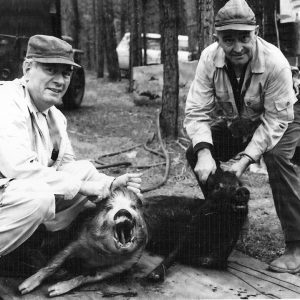calsfoundation@cals.org
Razorbacks Hogs
Arkansas was known for its razorback hogs long before the University of Arkansas mascot came into being. These wild boars were called razorbacks because of their high, hair-covered backbone and ill-mannered temper. The razorback hog was considered ruthless and dangerous when backed into a corner.
The true wild boar, also called the European or Russian boar, is not native to the United States. Christopher Columbus introduced their domesticated ancestors to the New World in 1493. Wild boars are thought to have arrived with explorer Hernando de Soto, who brought the original thirteen grunting hogs to the new world in 1539, though this theory has lately been cast into doubt by Charles Hudson, who reconstructs de Soto’s path in his book, Knights Of Spain, Warriors Of The Sun (University of Georgia Press, 1997).
Domestic swine arrived in Arkansas with the first settlers. Many escaped from their owners and headed for the hills, where they established breeding grounds and roamed town streets. Over time, these feral pigs interbred with their wild counterparts and became what we now call “wild boars.” Settlers would trap the hogs in large pens and take them to market. This practice continued into the twentieth century, but the Depression forced many farmers to leave their country lifestyle for a more stable life in town. Today, feral hogs are present in more than fifty Arkansas counties.
The most common color for feral hogs is black. Boars have long, bristly hair, high shoulders, a sloping rump, long, skinny legs, and small hips. The massive wedge-shaped head with short, hairy, erect ears ends in a pointed snout. The nose is almost round and looks and feels somewhat soft but must be one of the most efficient rooting machines of any animal. Boars dig up fields of crops with ease.
A mature male is 4′ to 5′ long and weighs 150–300 pounds. Females are slightly smaller. The boar has long tusks. The upper tusks rub against the lower ones and sharpen them. The boar’s body armor of fat, gristle, and tendons can be more than an inch thick. It starts around the neck and extends just past the lower ribs.
Boars adapt to various habitats as long as there is a reliable source of water. If they have a weakness, it is a low tolerance for heat. They make “wallows” to cool and protect themselves from insects and lice. A lot of the wild hogs in Arkansas are found in swampy terrain.
Wild boars are intelligent, equipped with keen senses, swift, wary, easily agitated, and aggressive when cornered. They can move thirty-five miles per hour and are constantly on the move, even when feeding.
Problems with wild hogs are numerous. They uproot plants and will eat anything they can catch, including young mammals. They destroy terrestrial and aquatic vegetation, ruin water holes used by other wildlife, and contribute to erosion and siltation, which can degrade water quality. They can transmit brucellosis and other diseases to domestic animals. There have been cases in Arkansas of feral hogs transmitting brucellosis and trichinosis to humans.
Despite the problems hogs cause, they provide great hunting opportunities for the expert hunter. There are still wild hogs roaming free on Arkansas Game and Fish and federal hunting lands.
For additional information:
“Feral Hogs.” Arkansas Game and Fish Commission. https://www.agfc.com/en/hunting/feral-hogs/ (accessed July 27, 2023).
Foti, Thomas, and Gerald Hanson. Arkansas and the Land. Fayetteville: University of Arkansas Press, 1992.
Lancaster, Bob. “The Adelantado’s Pigs.” Arkansas Times, January 1986, 65–76.
“Laws and Regulations Governing Feral Hogs in Arkansas.” University of Arkansas Cooperative Extension Service. https://www.uaex.uada.edu/publications/pdf/FSA-9106.pdf (accessed July 27, 2023).
Tina Easley
Paragould, Arkansas
 Razorback Hunters
Razorback Hunters  Razorback Statue
Razorback Statue 



Comments
No comments on this entry yet.